In today’s digital-first world, your website isn’t just a virtual brochure—it’s your storefront, sales team, and customer service rep all rolled into one. That’s why using a custom website page template is no longer just a “nice-to-have”—it’s a strategic advantage.
Unlike cookie-cutter designs that box your brand into pre-set layouts, a custom template gives your business the freedom to shine, the flexibility to grow, and the tools to convert more visitors into loyal customers. Whether you’re launching a startup, rebranding your business, or optimizing for conversions, investing in a custom solution is one of the smartest moves you can make.
In this article, we’ll break down 7 powerful reasons why a custom website page template can be a game-changer for your business—especially if you’re serious about standing out, scaling fast, and staying ahead of the competition.
Let’s dive in.
Tailored Branding & Design
A custom website page template isn’t just about looking pretty—it’s about purpose. When you opt for a tailored design, every pixel, every section, and every user interaction is carefully crafted to reflect your brand identity. You’re not settling for someone else’s vision. You’re creating your own digital voice.
Consistency Across Pages
Consistency builds trust. If your homepage has a unique layout but your service or product pages look disjointed, your visitors will feel it—and not in a good way. A custom website page template ensures that your entire site speaks the same visual language. Fonts, colors, buttons, spacing, icons, and image styles all work in harmony, creating a seamless journey from the first click to conversion.
Think of it like this: big brands like Apple, Nike, or Airbnb have flawless visual consistency across every single page of their websites. That didn’t happen by chance—it’s the result of intentional, customized templates built to maintain design integrity at every stage.
This consistency is also crucial for brand recall. Users subconsciously remember design elements that resonate—whether it’s the exact shade of blue you use, or the style of your product thumbnails. The more consistent you are, the more memorable you become.
First Impressions That Convert
You only get one chance to make a first impression—and in the digital world, you have about 3 seconds to make it count.
A custom website page template is designed to engage immediately. Unlike generic templates that often overload the page with unnecessary clutter, a custom template focuses on what matters most to your audience. The layout is optimized for your messaging, your call-to-action (CTA), and your ideal customer journey.
Custom templates also help guide user behavior through strategic content placement. Want your users to click the “Book a Demo” button? A custom template will lead them there intuitively—with zero friction. Want to highlight a new product launch or feature? The design will spotlight it front and center, in your brand’s tone and style.
Moreover, a tailored design adds an element of professionalism. Your audience can instantly sense the difference between a DIY website and one that was built with intention. That credibility often translates into higher engagement and, ultimately, better conversion rates.
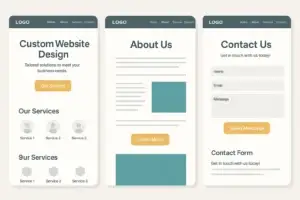
Better SEO Performance
If you want your website to be seen, it has to be found. And being found means ranking well on search engines like Google. A custom website page template gives you a serious edge here—because it’s built with SEO in mind from the ground up.
Clean Code & Structure
Search engines love websites with clean, semantic code. Unlike pre-made templates that often come bloated with unnecessary scripts, plugins, or third-party libraries, a custom template is streamlined. That means faster load times, fewer errors, and better crawlability by search engine bots.
With a custom build, developers can structure HTML with precise heading hierarchies (H1, H2, H3), optimized image tags, proper meta data implementation, and more. All of this feeds into technical SEO, which is one of the most overlooked—yet crucial—ranking factors.
Plus, there’s no leftover template junk from features you’re not using. Pre-made templates are built to cover every possible use case, which often leads to code bloat. Custom templates include only what’s needed, making your site faster and leaner.
Customization for Search Intent
Great SEO isn’t just technical—it’s strategic. Your content should match what your audience is actually searching for. With a custom website page template, your layout can be designed to align with specific search intent.
For example, if you want to rank for a long-tail keyword like “affordable interior design services in Chicago,” your service page can be custom-structured to include:
-
A location-focused H1 headline
-
A dedicated pricing section
-
Customer testimonials from that city
-
A map showing your office
-
CTAs that align with local search intent
You’re not forced to squeeze this into a rigid, one-size-fits-all template. You can design the page around what your customers—and Google—want to see.
Moreover, a custom layout allows for better internal linking, improving your site architecture. You can plan silo structures, build category clusters, and guide both users and bots through your content logically.
And let’s not forget about Core Web Vitals—the real-time metrics Google uses to evaluate user experience (like load speed, interactivity, and layout shifts). Custom templates can be built to pass these metrics with flying colors.
The result?
Higher rankings, better visibility, more organic traffic—and ultimately, more business.
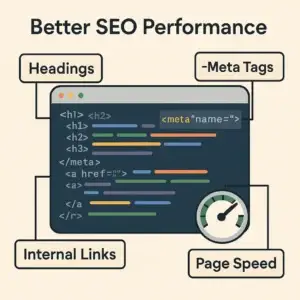
Enhanced User Experience (UX)
User experience isn’t just a trendy buzzword—it’s the foundation of any successful website. If your visitors can’t navigate your site easily, find the information they need quickly, or complete actions without frustration, you lose them—often for good. This is where a custom website page template truly shines.
Faster Load Times
Speed is everything online. According to Google, 53% of users abandon a site if it takes longer than 3 seconds to load. Custom templates are designed with performance in mind. They’re lean, focused, and avoid the bloated code that often comes with off-the-shelf themes.
At Curtis Design, we’ve seen firsthand how businesses benefit from faster websites. When we build a custom page template, we control every element: image sizes, script loading behavior, CSS prioritization—you name it. This meticulous optimization results in lightning-fast page loads, which not only improves user satisfaction but also gives a direct boost to your SEO rankings.
Plus, fast-loading sites reduce bounce rates and increase average time on page—two metrics Google loves.
Device Responsiveness
Your audience isn’t just browsing on desktops anymore. In fact, over 60% of all website traffic comes from mobile devices. If your site doesn’t adapt beautifully to smartphones, tablets, and every screen size in between, you’re not just losing traffic—you’re losing trust.
A custom website page template ensures your design is fully responsive and purpose-built for mobile. This isn’t just about shrinking things down. It’s about optimizing layouts for touch gestures, thumb-friendly CTAs, collapsible menus, and legible typography on smaller screens.
Unlike many pre-made templates that claim to be “responsive” but break under real-world usage, custom templates are tested and fine-tuned for every screen size and browser environment.
At Curtis Design, we conduct rigorous mobile UX audits during development, ensuring your users enjoy the same seamless experience—whether they’re visiting from a MacBook, an iPhone, or a smart TV.
And when users have a good experience, they stay longer, engage more, and convert better. It’s that simple.
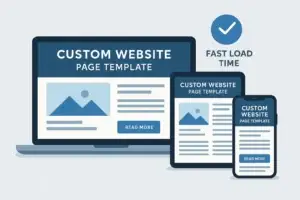
Scalability & Flexibility
As your business grows, your website needs to grow with it. Whether you’re adding new services, expanding to new markets, or integrating more advanced features, scalability becomes non-negotiable. A custom website page template provides the ideal foundation for this kind of long-term, strategic growth.
Built to Grow With You
Generic templates may serve you fine on day one. But fast-forward six months—what happens when you want to launch a new service line, add dynamic pricing calculators, or implement CRM integrations? With a custom template, you don’t need to tear everything down and start over.
At Curtis Design, we engineer every custom template with modularity in mind. That means pages, sections, and components are built in reusable blocks. Want to clone a landing page with a different offer? Easy. Need to add a new product page that mimics the styling of existing ones? Done.
This future-proof design approach ensures your website adapts to your business, not the other way around.
Think of your custom template as a digital ecosystem—capable of expanding, evolving, and adapting to whatever your brand demands. You’re not locked into someone else’s roadmap. You control the journey.
Modular Design for Easy Expansion
A major strength of custom templates is the flexibility that comes from modular design. Instead of static page layouts that force you into rigid formats, your site is built from dynamic components: hero sections, testimonial sliders, pricing tables, content blocks, CTA buttons—each of which can be placed, rearranged, or duplicated with ease.
This modularity makes site-wide changes dramatically faster. For example:
-
Want to update a CTA across 20 pages? One global change handles it.
-
Need to translate your site for a second language? Modules make localization easier.
-
Launching a holiday promo? Drop in a custom promotional banner wherever you need it—without touching raw code.
With scalability baked in, your website becomes a living tool, not a static brochure.
Moreover, when your custom template is built with flexibility in mind, it’s much easier to integrate third-party tools—whether it’s e-commerce platforms, lead capture forms, chatbots, or analytics systems. You’re not limited by what a theme supports. You define what your site should do—and your template rises to the task.
And here’s the best part: this scalability doesn’t come at the cost of speed or UX. Custom templates are carefully optimized so that even as your site grows in complexity, it remains fast, responsive, and easy to use.
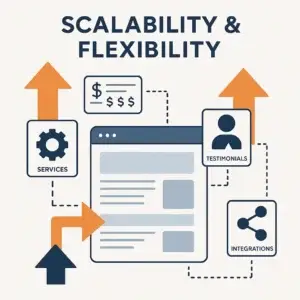
Fewer Limitations than Pre-Made Templates
Pre-made templates promise a quick launch. They look decent at first glance, and they seem like a cost-effective solution. But once you try to customize anything beyond the basics, those same templates begin to feel like a digital straightjacket.
By contrast, a custom website page template removes those limits entirely. You’re not tweaking someone else’s vision—you’re implementing your own.
Full Creative Freedom
Most pre-made templates force you into predetermined layouts. Want to move that pricing section above testimonials? Sorry—it’s locked. Need to redesign the navigation for better UX? Not possible without breaking something. Want to create a completely different layout for your blog or service pages? You’re out of luck.
But with a custom template, you get complete creative control. The layout, the animations, the spacing, the flow—it’s all designed to match your brand voice and user journey. There are no rules except the ones you define.
This freedom is especially important for brands that want to stand out. At Curtis Design, we believe that your website should never look like your competitor’s. With custom design, your online presence becomes a one-of-a-kind experience that’s tailored to your audience—not adapted to fit inside a mold.
And when you need to pivot—whether that means rebranding, launching a campaign, or adding a new type of content—your template can evolve with you, not against you.
No Generic Look
There’s a reason you can often spot a template-based website from a mile away—they all look the same.
Pre-made templates are designed to be one-size-fits-all, which means they often lack character. They might look sleek, but they’re also generic, repetitive, and easily forgettable.
Custom templates, on the other hand, give your site personality. Want to use bold animations, interactive storytelling, or unique section transitions? You can. Want a layout that mirrors your sales funnel step-by-step? Go for it. Want to integrate a branded visual experience that aligns with your offline materials? Done.
Plus, a custom website page template lets you remove elements you don’t need, reducing clutter and focusing user attention where it matters most.
This results in a website that doesn’t just look better—it functions better. Every page is designed with intention, not compromise.
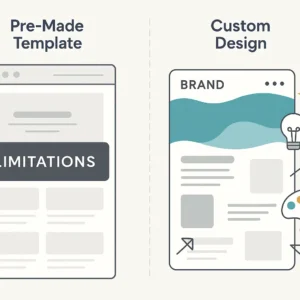
Improved Conversion Rates
Design isn’t just about making things look pretty—it’s about getting users to take action. And when your goal is conversions—whether that means leads, purchases, downloads, or bookings—a custom website page template becomes your best ally.
Why? Because it’s built around your unique sales funnel. Every element on the page is intentionally placed to guide visitors through the buyer journey—without friction or confusion.
Built for Your Funnel
Most pre-made templates are created to fit every type of business. That sounds good in theory, but in practice, it means they’re optimized for none. A custom template, however, is mapped directly to your business model, customer psychology, and marketing goals.
At Curtis Design, we study the user journey in detail. Where do people usually drop off? Where do they hesitate? Which buttons drive the most action? All of this data informs how we structure the template.
For example, if your goal is to book consultations, we’ll design your homepage to gently—but strategically—nudge users toward that goal:
-
Attention-grabbing headline ✅
-
Pain-point paragraph ✅
-
Value proposition ✅
-
Trust signals (testimonials, logos, stats) ✅
-
Then—boom—Book a Free Call CTA button right when they’re most convinced.
This isn’t guesswork. It’s conversion science, baked right into your custom layout.
Custom CTAs and Layout Logic
Calls to Action (CTAs) are the make-or-break moment of every page. But most templates bury them, use vague language like “Learn More,” or don’t give you room to design your own buttons with personality.
With a custom template, every CTA is intentional. You decide:
-
What the CTA says (“Let’s Talk,” “Start My Free Trial,” “Get Instant Quote”)
-
Where it appears (above the fold, in sticky headers, in page footers)
-
How it looks (color, animation, hover effect)
And you’re not limited to one CTA per page. Depending on your funnel stage, you can design micro-conversions:
-
Newsletter sign-ups
-
Lead magnets (free downloads)
-
Social follows
-
Multi-step forms
Best of all, you can A/B test different versions easily when the site is built with a modular, flexible structure.
Bottom line? A custom website page template gives you the control, precision, and flexibility you need to boost your conversion rates and scale your business more effectively.
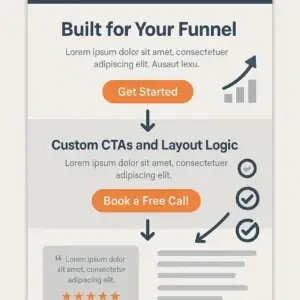
Long-Term Cost Efficiency
Let’s be honest—custom website templates require more upfront investment. But here’s the thing: they’re not an expense—they’re an asset. And over time, that asset pays for itself many times over.
In contrast, most businesses that opt for a low-cost pre-made template eventually find themselves spending more—in lost conversions, dev time fixing limitations, redesigns, and ongoing patchwork.
Here’s why a custom website page template is the smart, cost-efficient choice in the long run.
Pay Once, Scale Forever
When you build a custom template, you’re not just buying a pretty design—you’re building infrastructure that can support your business for years. Think of it like building a custom home versus renting a prefab unit. You own it. You can expand it. And you can tailor it to your exact needs.
Compare that to a typical template journey:
-
Buy a template for $59 ✅
-
Spend $500 tweaking it ✅
-
Run into limitations 3 months later ✅
-
Hire a dev to hack new features ✅
-
Redesign the whole site in a year ✅
It adds up. What you thought was a “cheap” solution ends up becoming a money pit.
At Curtis Design, we build websites with longevity in mind. Our clients aren’t redesigning their sites every 12–18 months. Instead, we give them a platform they can evolve, iterate on, and expand—without starting from scratch.
Less Maintenance Over Time
Pre-made templates often rely on third-party plugins to function. That means constant updates, plugin conflicts, and potential security vulnerabilities. It also means higher ongoing maintenance costs.
With a custom template, you reduce those risks dramatically. Your site is:
-
Lean and clean — fewer plugins = fewer issues
-
Secure — custom-built with security best practices
-
Stable — fewer breaking updates or compatibility issues
-
Efficient — optimized for your hosting environment
That means fewer dev hours, fewer emergencies, and fewer headaches. More time focusing on growing your business, and less time worrying about your website breaking on launch day.
And the best part? A well-built custom site is easier to update over time. Want to refresh a layout? Add a landing page? Integrate new tech? You can, without starting over or spending thousands every time.
When you look at the total cost of ownership over 2–3 years, a custom website page template isn’t just more powerful—it’s more affordable.
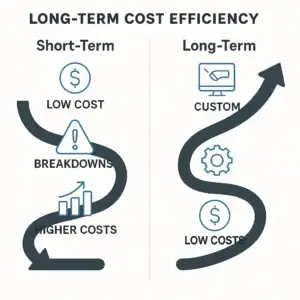
Conclusion: Is a Custom Website Page Template Worth It?
In a world where every business has a website, only a few truly stand out—and those that do often have one thing in common: a custom-built foundation that’s tailored to their brand, optimized for performance, and designed for growth.
We’ve explored seven compelling reasons why investing in a custom website page template isn’t just a design decision—it’s a strategic business move. From branding consistency to better SEO, from scalable architecture to higher conversion rates, the advantages are both immediate and long-lasting.
Yes, the upfront cost is higher than picking a $59 theme off a marketplace. But that cost is quickly offset by:
-
Better rankings and visibility
-
Higher engagement and trust
-
More leads and sales
-
Less time spent fixing template limitations
-
And a truly memorable digital experience for your users
At Curtis Design, we don’t just build pretty pages. We create conversion-focused, brand-aligned, scalable web experiences that are crafted to perform.
If your website is more than just an online brochure—if it’s a growth tool, a lead generator, and a brand touchpoint—then you owe it to yourself to go custom.
👉 Ready to elevate your online presence with a custom solution?
Visit curtisdesign.com and let’s build something powerful—together.
Frequently Asked Questions (FAQ)
What exactly is a custom website page template?
A custom website page template is a uniquely designed layout built specifically for your brand, goals, and users. It’s not pulled from a generic template marketplace—it’s created from scratch to deliver the best performance, design, and user experience possible.
How is it different from a regular template?
Pre-made templates are designed for anyone and everyone, which means they come with limitations. A custom template is tailored to your exact needs—no restrictions, no bloated code, and full design freedom.
Is a custom template worth the extra cost?
Absolutely. While it may cost more upfront, the return on investment is significantly higher in terms of SEO performance, conversion rates, branding, and long-term scalability. Plus, you’ll spend less on fixes and redesigns later.
Can I still manage my content easily with a custom template?
Yes! Most custom templates are built with user-friendly CMS platforms (like WordPress or Webflow) in mind. You can still edit text, swap images, and manage pages without needing to touch any code.
How long does it take to build a custom website template?
It depends on the complexity of the design and functionality. Typically, a fully custom site with multiple page templates can take 4–8 weeks from concept to launch.
Will my custom template be mobile responsive?
Definitely. At Curtis Design, we build all custom templates to be fully responsive—optimized for every screen size, device, and browser—ensuring a seamless experience for every visitor.
